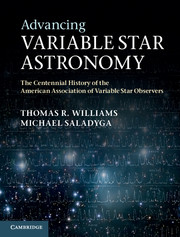 Advancing Variable Star Astronomy
Advancing Variable Star Astronomy Book contents
- Frontmatter
- Contents
- Foreword
- Preface
- Acknowledgments
- PART I PIONEERS IN VARIABLE STAR ASTRONOMY PRIOR TO 1909
- PART II THE FOUNDING OF THE AAVSO – THE WILLIAM TYLER OLCOTT ERA
- PART III RECORDING AND CLASSIFICATION – THE LEON CAMPBELL ERA
- PART IV THE SERVICE BUREAU – THE MARGARET MAYALL ERA
- PART V ANALYSIS AND SCIENCE – THE JANET MATTEI ERA
- 17 The growth of a director
- 18 Learning the ropes the hard way
- 19 Managing with renewed confidence
- 20 Expanding the scientific charter
- PART VI ACCELERATING OBSERVATIONAL SCIENCE – THE ARNE HENDEN ERA
- Appendix A AAVSO historiographic notes
- Appendix B Top AAVSO observer totals
- Appendix C Variable star observing groups represented in the AAVSO International Database
- Appendix D AAVSO Awards
- Appendix E Officers of the AAVSO
- Appendix F AAVSO Council members
- Appendix G AAVSO Scientific committee, section, division, and program chairs
- Notes
- Bibliography
- Index
18 - Learning the ropes the hard way
from PART V - ANALYSIS AND SCIENCE – THE JANET MATTEI ERA
Published online by Cambridge University Press: 13 June 2011
- Frontmatter
- Contents
- Foreword
- Preface
- Acknowledgments
- PART I PIONEERS IN VARIABLE STAR ASTRONOMY PRIOR TO 1909
- PART II THE FOUNDING OF THE AAVSO – THE WILLIAM TYLER OLCOTT ERA
- PART III RECORDING AND CLASSIFICATION – THE LEON CAMPBELL ERA
- PART IV THE SERVICE BUREAU – THE MARGARET MAYALL ERA
- PART V ANALYSIS AND SCIENCE – THE JANET MATTEI ERA
- 17 The growth of a director
- 18 Learning the ropes the hard way
- 19 Managing with renewed confidence
- 20 Expanding the scientific charter
- PART VI ACCELERATING OBSERVATIONAL SCIENCE – THE ARNE HENDEN ERA
- Appendix A AAVSO historiographic notes
- Appendix B Top AAVSO observer totals
- Appendix C Variable star observing groups represented in the AAVSO International Database
- Appendix D AAVSO Awards
- Appendix E Officers of the AAVSO
- Appendix F AAVSO Council members
- Appendix G AAVSO Scientific committee, section, division, and program chairs
- Notes
- Bibliography
- Index
Summary
Twentieth century amateur astronomers have seldom had access to the advanced equipment that their talent and dedication deserves. That needs changing.
– Riccardo GiacconiIn late 1973 and over the next 7 years, Janet Mattei was forced to deal with a multitude of problems that had been developing during the difficult years, after the eviction from Harvard. Membership continued to grow, and the annual total of observations submitted to headquarters grew even faster as international observers began to accelerate their contributions.
Although the commitment to modern data processing technology had been made, headquarters could not keep up with the growing volume of incoming data. Furthermore, observations still on keypunched cards needed to be converted to light curves so that the ever-increasing volume of questions from the professional community could be answered quickly. Arrangements for semiannual meetings and hand-plotting of light curves constituted an overwhelming workload for Mattei and left her too little time for membership communication and development of professional relations. A crisis erupted in the Council over the handling of The AAVSO Atlas, and then JAAVSO editors resigned. Seeing these crises as opportunities, Mattei began gaining control over the operation and gradually won the confidence of the Council.
Information
- Type
- Chapter
- Information
- Advancing Variable Star AstronomyThe Centennial History of the American Association of Variable Star Observers, pp. 257 - 274Publisher: Cambridge University PressPrint publication year: 2011